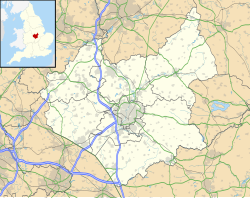
Royal Air Force Kenley, more commonly known as RAF Kenley, is a former station of the Royal Flying Corps in the First World War and the RAF in the Second World War. It played a significant role during the Battle of Britain as one of the three RAF stations specifically tasked with the defence of London. It is located near Kenley on the edge of Greater London. The site remains in use with the Ministry of Defence, as Kenley Airfield.

London Biggin Hill Airport is a minor commercial airport serving Biggin Hill in the London Borough of Bromley, located 12 NM south-southeast of Central London. It specialises in general aviation, handling a spectrum of traffic from private aviation to large business jets. It currently has no scheduled airline service, as flights using the airport are not regularly permitted to carry fare-paying passengers.
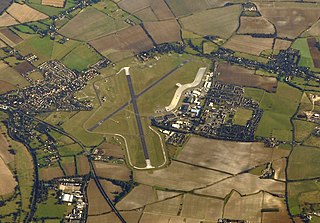
Royal Air Force Benson or RAF Benson is a Royal Air Force (RAF) station located at Benson, near Wallingford, in South Oxfordshire, England. It is a front-line station and home to the RAF's fleet of Westland Puma HC2 support helicopters, used primarily for the transportation of troops & equipment. Flying squadrons comprise No. 33 Squadron flying the Puma, No. 22 Squadron which provides operational evaluation and training for all aircraft in Joint Aviation Command and No. 28 Squadron, which is the combined Puma and Boeing Chinook HC6A training unit. Other units include the Oxford University Air Squadron and No. 6 Air Experience Flight, both flying the Grob Tutor T1 light training aircraft used for student and cadet flying training. The National Police Air Service and the Thames Valley Air Ambulance are also based at the station, both operating Airbus H135 helicopters.

Royal Air Force Digby otherwise known as RAF Digby is a Royal Air Force station located near Scopwick and 11.6 mi (18.7 km) south east of Lincoln, in Lincolnshire, England. The station is home to the tri-service Joint Service Signals Organisation, part of the Joint Forces Intelligence Group of Joint Forces Command. Other units include the RAF Aerial Erector School, No. 54 Signals Unit and No. 591 Signals Unit.
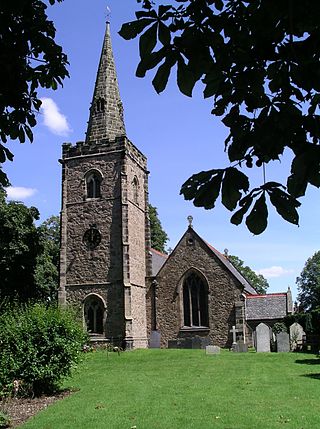
Desford is a village and civil parish in the Hinckley and Bosworth district of England, 7 miles (11 km) west of the centre of Leicester and around 7 miles north east of Hinckley. Situated on a hill approximately 400 feet above sea level, the parish includes the hamlets of Botcheston and Newtown Unthank and a scattered settlement at Lindridge. The population at the 2021 census had increased to 4,592. Desford is in the Doomsday Book of 1086 but the name itself is older than that meaning Deor's Ford suggesting an Anglo Saxon origin. Another suggestion is that it means 'ford frequented with wild animals'.

Royal Naval Air Station Lee-on-Solent,, is a former Royal Naval Air Station located near Lee-on-the-Solent in Hampshire, approximately 4 miles (6.44 km) west of Portsmouth, on the coast of the Solent.
Royal Air Force Ringway or more simply RAF Ringway is a former Royal Air Force satellite station in Ringway, Cheshire, England, near Manchester. It was operational from 1939 until 1957. The site of the station is now occupied by Manchester Airport.
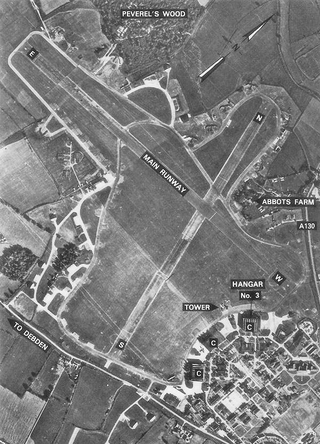
Royal Air Force Debden or more simply RAF Debden is a former Royal Air Force station located 3 miles (4.8 km) southeast of Saffron Walden and approximately 1 mile (1.6 km) north of the village of Debden in north Essex, England
Royal Air Force Drem, or more simply RAF Drem, is a former Royal Air Force station, just north of the village of Drem in East Lothian, Scotland. The motto of the station was Exiit Hinc Lumen which means "Light has departed from this place".

RAF Yatesbury is a former Royal Air Force airfield near the village of Yatesbury, Wiltshire, England, about 4 miles (6 km) east of the town of Calne. It was an important training establishment in the First and Second World Wars and until its closure in 1965. For a time in the 1950s, part of the site became RAF Cherhill.

Redhill Aerodrome is an operational general aviation aerodrome located 1.5 NM south-east of Redhill, Surrey, England, in green belt land. It also serves as an important reliever airport for Gatwick airport.
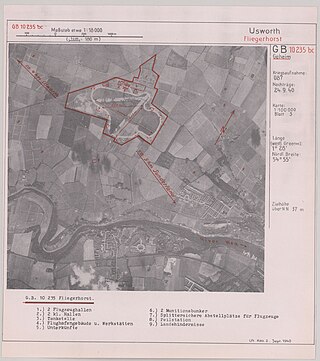
Royal Air Force Sunderland or RAF Sunderland is a former Royal Air Force station in Sunderland. In 1958 the station was closed and the airfield became Sunderland Airport. Following the closure of the airport in 1984, the site has since been redeveloped as a manufacturing facility for Nissan cars – Nissan Motor Manufacturing UK, and as the location of an aviation museum, the North East Land, Sea and Air Museums (NELSAM).
Royal Air Force Filton or more simply RAF Filton is a former Royal Flying Corps (RFC) and Royal Air Force (RAF) station located 5 miles (8 km) north of the city centre of Bristol, England.

Middle Wallop Flying Station is a British Army airfield located near the Hampshire village of Middle Wallop. It is the Headquarters for the Army Air Corps, and the 1st Aviation Brigade Combat Team, and is also used for Army Air Corps training. The base hosts 2 (Training) Regiment AAC and 7 (Training) Regiment AAC under the umbrella of the Army Aviation Centre. 2 Regiment performs ground training; 7 Regiment trains aircrew on AAC aircraft after they complete basic training at RAF Shawbury.

Royal Air Force Llandow or more simply RAF Llandow is a former Royal Air Force station situated near the village of Llandow, Vale of Glamorgan, South Wales, 15 miles (24 km) west of Cardiff.
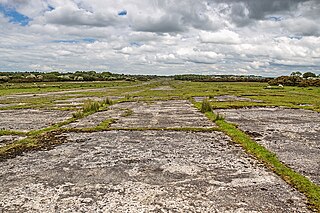
Royal Air Force Templeton, or more simply RAF Templeton, is a former Royal Air Force station located 9.75 miles (15.69 km) south east of Haverfordwest, Pembrokeshire and 10 miles (16 km) north east of Pembroke Dock, Pembrokeshire, Wales.

Netheravon Airfield is a Ministry of Defence grass strip airfield on Salisbury Plain, in Wiltshire, England. Established in 1913 by the Royal Flying Corps, it became RAF Netheravon from 1918 until 1963, then AAC Netheravon until 2012. Buildings from 1913 and 1914 survive on part of the site. The site forms part of the Tidworth, Netheravon and Bulford (TidNBul) Garrison.
Reid and Sigrist was an English engineering company based at New Malden in Surrey. It later acquired sites at Desford and Braunstone in Leicestershire. Initially it developed and manufactured aircraft instrumentation and pilot selection aids but later diversified into flying training and aircraft design. During World War II the company was part of the Civilian Repair Organisation repairing, rebuilding and converting warplanes at the Desford site. Post-war, it continued to manufacture aviation instruments and guidance systems but also diversified further to produce cameras and optical instruments. In 1954, the company was purchased and taken over by the Decca Record Company.

Royal Air Force Sutton Bridge or more simply RAF Sutton Bridge is a former Royal Air Force station found next to the village of Sutton Bridge in the south-east of Lincolnshire. The airfield was to the south of the current A17, and east of the River Nene, next to Walpole in Norfolk.

